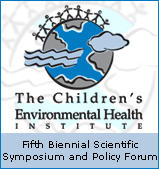| Residential Traffic and Children's Respiratory Health Janice J. Kim,1 Karen Huen,1,2 Sara Adams,1* Svetlana Smorodinsky,3 Abby Hoats,4 Brian Malig,1 Michael Lipsett,3 and Bart Ostro1 1Office of Environmental Health Hazard Assessment, Air Pollution Epidemiology Section, Oakland, California, USA; 2Environmental Health Sciences, School of Public Health, University of California, Berkeley, California, USA; 3Environmental Health Investigations Branch, California Department of Public Health, Richmond, California, USA; 4Impact Assessment, Inc., La Jolla, California, USA Abstract
Background: Living near traffic has been associated with asthma and other respiratory symptoms. Most studies, however, have been conducted in areas with high background levels of ambient air pollution, making it challenging to isolate an independent effect of traffic. Additionally, most investigations have used surrogates of exposure, and few have measured traffic pollutants directly as part of the study. Objective: We conducted a cross-sectional study of current asthma and other respiratory symptoms in children (n = 1,080) living at varying distances from high-traffic roads in the San Francisco Bay Area, California, a highly urbanized region characterized by good regional air quality due to coastal breezes. Methods: We obtained health information and home environmental factors by parental questionnaire. We assessed exposure with several measures of residential proximity to traffic calculated using geographic information systems, including traffic within a given radius and distance to major roads. We also measured traffic-related pollutants (nitrogen oxides and nitrogen dioxide) for a subset of households to determine how well traffic metrics correlated with measured traffic pollutants. Results: Using multivariate logistic regression analyses, we found associations between current asthma and residential proximity to traffic. For several traffic metrics, children whose residences were in the highest quintile of exposure had approximately twice the adjusted odds of current asthma (i.e., asthma episode in the preceeding 12 months) compared with children whose residences were within the lowest quintile. The highest risks were among those living within 75 m of a freeway/highway. Most traffic metrics correlated moderately well with actual pollutant measurements. Conclusion: Our findings provide evidence that even in an area with good regional air quality, proximity to traffic is associated with adverse respiratory health effects in children. Key words: air pollution, asthma, bronchitis, children, respiratory health, traffic. Environ Health Perspect 116:1274–1279 (2008) . doi:10.1289/ehp.10735 available via http://dx.doi.org/ [Online 27 May 2008]
Address correspondence to B. Ostro, Office of Environmental Health Hazard Assessment, Air Toxicology and Epidemiology Branch, 1515 Clay St., 16th Floor, Oakland, CA 94612 USA. Telephone: (510) 622-3157. Fax: (510) 622-3210. E-mail: Bostro@oehha.ca.gov Supplemental Material is available online at http://www.ehponline.org/members/2008/10735/suppl.pdf *Current address: ICON Clinical Research, San Francisco, CA, USA. We thank B. Singer, A.T. Hodgson, and T. Hotchi, Lawrence Berkeley National Laboratories, for work on the air monitoring study ; J. Hayes and D. Eisenhower, Survey Research Center, University of California, Berkeley, for coordinating the survey ; C. Wolff, California Department of Public Health, for providing the traffic data layer ; and staff of the Air Resources Board for reviewing earlier drafts. We also thank the school districts, principals, teachers, and all study participants and their families for their time and commitment to this project. This study was supported in part by the California Air Resources Board (contract 03-327) , the U.S. Environmental Protection Agency, Region IX (CH-97942501-2) , and the Centers for Disease Control and Prevention (under cooperative agreement U50/CCU922449 with the California Department of Health Services) . The contents and opinions expressed in this article are solely those of the authors and do not represent the official policy or position of the Office of Environmental Health Hazard Assessment, the California Environmental Protection Agency, or the California Department of Public Health. A.H., a research assistant with Impact Assessment, Inc. at the time of this project, is currently employed by Chevron Energy Technology Corporation. The other authors declare they have no competing financial interests. Received 4 August 2007 ; accepted 22 May 2008.
The full version of this article is available for free in HTML or PDF formats. |

